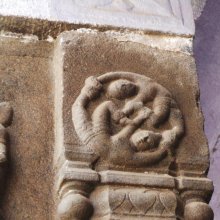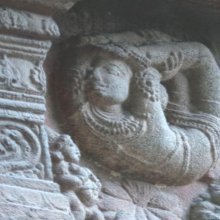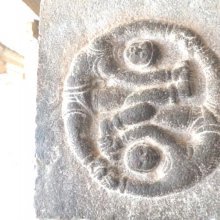Shakatasya, Śakaṭāsyā, Shakata-asya, Śakaṭāsya: 3 definitions
Introduction:
Shakatasya means something in Hinduism, Sanskrit. If you want to know the exact meaning, history, etymology or English translation of this term then check out the descriptions on this page. Add your comment or reference to a book if you want to contribute to this summary article.
The Sanskrit terms Śakaṭāsyā and Śakaṭāsya can be transliterated into English as Sakatasya or Shakatasya, using the IAST transliteration scheme (?).
Images (photo gallery)
In Hinduism
Natyashastra (theatrics and dramaturgy)
Source: Wisdom Library: Nāṭya-śāstra1) Śakaṭāsya (शकटास्य).—One of the 108 karaṇas (minor dance movement) mentioned in the Nāṭyaśāstra chapter 4. The instructions for this śakaṭāsya-karaṇa is as follows, “beginning with body at rest, advancing with a Talasañcara[50] foot and making the chest Udvāhita.”.
A karaṇa represents a minor dance movements and combines sthāna (standing position), cārī (foot and leg movement) and nṛttahasta (hands in dancing position).
2) Śakaṭāsyā (शकटास्या) refers to a one of the thirty-two cārīs, according to the Nāṭyaśāstra chapter 11. The Śakaṭāsyā-cārī is classified as a bhaumī, or “earthly”, of which there are sixteen in total. The term cārī refers to a “dance-step” and refers to the simultaneous movement of the feet (pāda), shanks (jaṅghā) and the hip (ūru). From these cārīs proceed dance as well as movements in general.
3) Śakaṭāsyā (शकटास्या) also refers to a one of the twenty maṇḍalas, according to the Nāṭyaśāstra chapter 12. The Śakaṭāsyā-maṇḍala is classified as a bhūmi, or “earthly”, of which there are ten in total. A maṇḍala is a combination of cārīs (“dance-steps”), which refers refers to the simultaneous movement of the feet (pāda), shanks (jaṅghā) and the hip (ūru). From these cārīs proceed dance as well as movements in general.
Source: archive.org: Natya Shastra1) Śakaṭāsyā (शकटास्या).—A type of earthly (bhaumī) dance-step (cārī);—Instructions: the body held upright, one Agratalasañcara foot put forward and the breast being Udvāhita.
2) Śakaṭāsya (शकटास्य).—A type of maṇḍala (series of cārīs) classified as earthly (bhūmi);—Instructions:
1a) The right foot (to be moved) in the janitā-cārī,
1b) and next to move in the talasañcara (nikuṭṭana) manner,
1c) the same foot in the śakaṭāsyā-cārī and the left foot in the syanditā-cārī,
2) moving round in this manner alternately with the śakaṭāsyā-cārī.
This cārī-maṇḍala named the śakaṭāsya is to be used in fight.

Natyashastra (नाट्यशास्त्र, nāṭyaśāstra) refers to both the ancient Indian tradition (shastra) of performing arts, (natya—theatrics, drama, dance, music), as well as the name of a Sanskrit work dealing with these subjects. It also teaches the rules for composing Dramatic plays (nataka), construction and performance of Theater, and Poetic works (kavya).
Languages of India and abroad
Kannada-English dictionary
Source: Alar: Kannada-English corpusŚakaṭāsya (ಶಕಟಾಸ್ಯ):—[noun] (dance.) a pushing the breast slightly forward while standing erect, and putting forward one foot .
Kannada is a Dravidian language (as opposed to the Indo-European language family) mainly spoken in the southwestern region of India.
See also (Relevant definitions)
Partial matches: Sakata, Asya.
Full-text: Adhyardha, Askandita, Atikranta, Avarta, Mandala, Bhramara, Carin, Addita.
Relevant text
Search found 2 books and stories containing Shakatasya, Śakaṭāsyā, Shakata-asya, Śakaṭāsya, Sakata-asya, Śakaṭa-āsya, Sakatasya; (plurals include: Shakatasyas, Śakaṭāsyās, asyas, Śakaṭāsyas, āsyas, Sakatasyas). You can also click to the full overview containing English textual excerpts. Below are direct links for the most relevant articles:
Natyashastra (English) (by Bharata-muni)
Gati in Theory and Practice (by Dr. Sujatha Mohan)
Performance of Gati through Maṇḍalas < [Chapter 2 - Concept and technique of Gati]
Gati in classical dance form of Oḍissi < [Chapter 4 - Practice of Gati]


